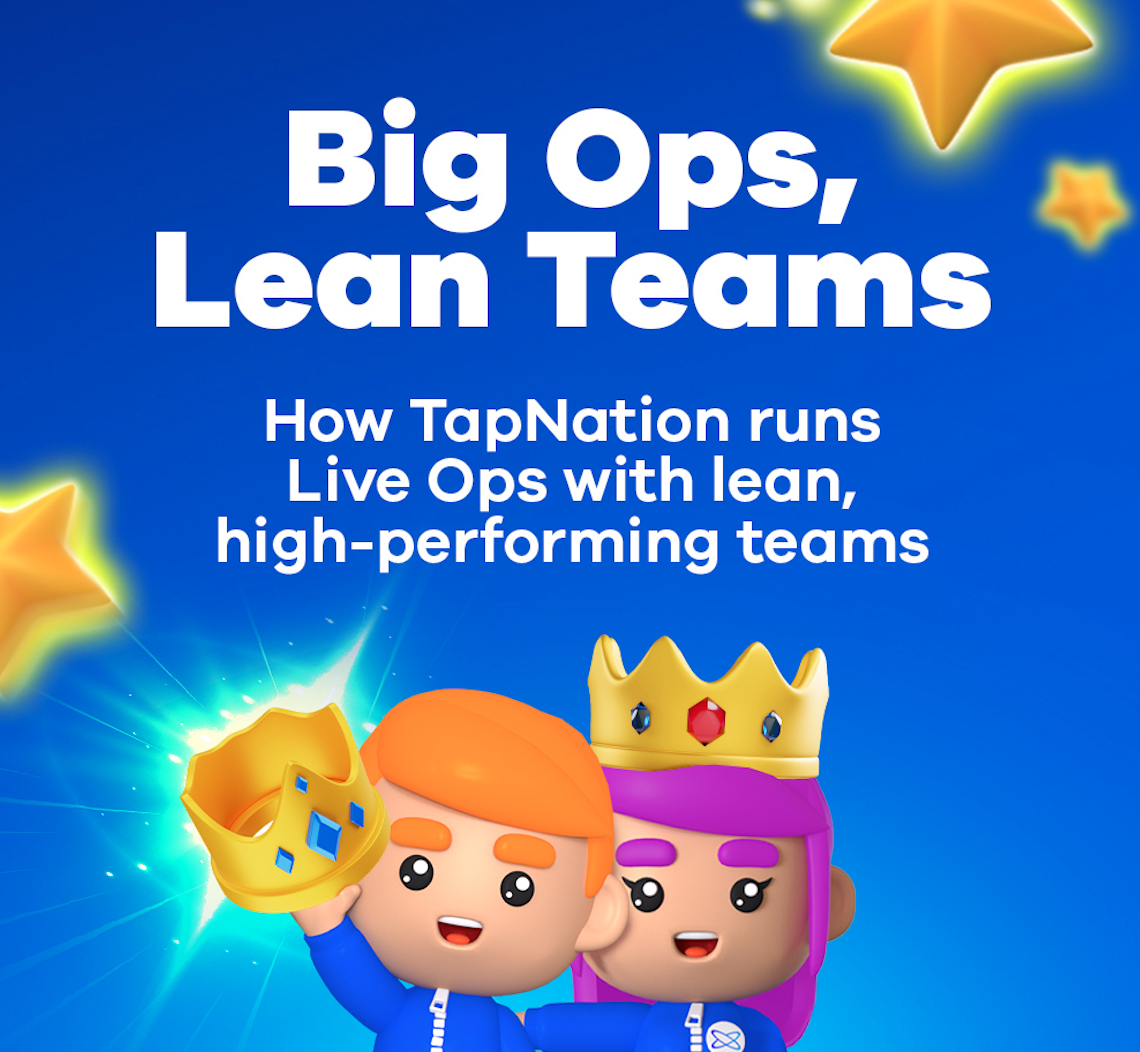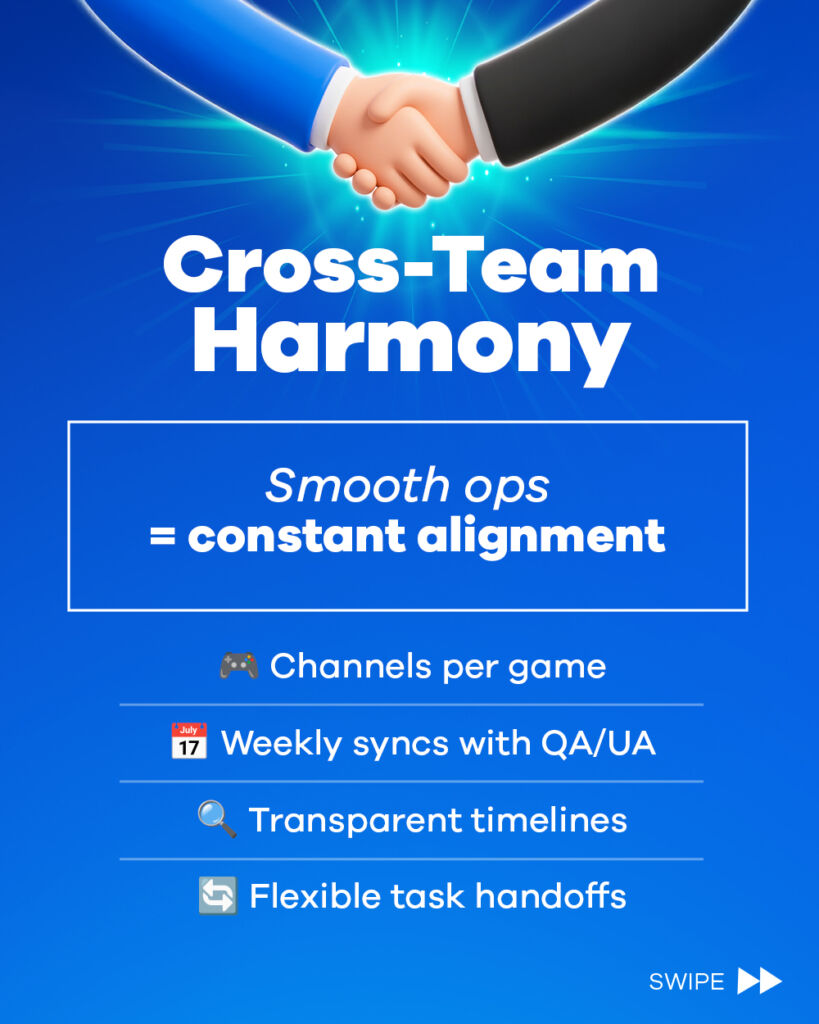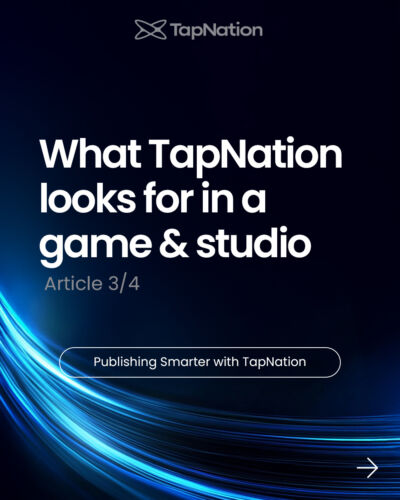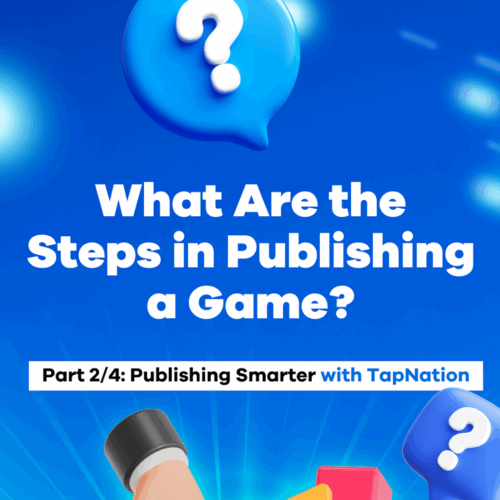Philippe Naffah – July 9, 2025
Summary
- Live Ops isn’t about team size — it’s about how you manage time, tools, and coordination.
- Limited hands, tight deadlines, slow feedback loops, context switching — they’re all part of the game when you run Live Ops with lean teams. But we’ve built systems that turn those pain points into performance.
- With compact resources, clear priorities and strong processes are essential for scaling multiple games at once.
- And yes — this model works. The results speak for themselves.
Introduction
Whether you’re a big studio or a compact team, Live Ops comes with challenges. The scale might differ — but the pressure is real either way. Some companies grow fast and build massive teams. At TapNation, we take a different approach: lean, focused, and efficient.
We run Live Ops with streamlined teams by design — not not because we have to — but because we know it scales smarter. Smaller teams mean faster feedback, clearer priorities, and better control over execution. It’s not about how many people you have — it’s about how well the work is managed.
Let’s break down the challenges this model brings — and how we’ve made it work at TapNation.
But first, a quick stop!
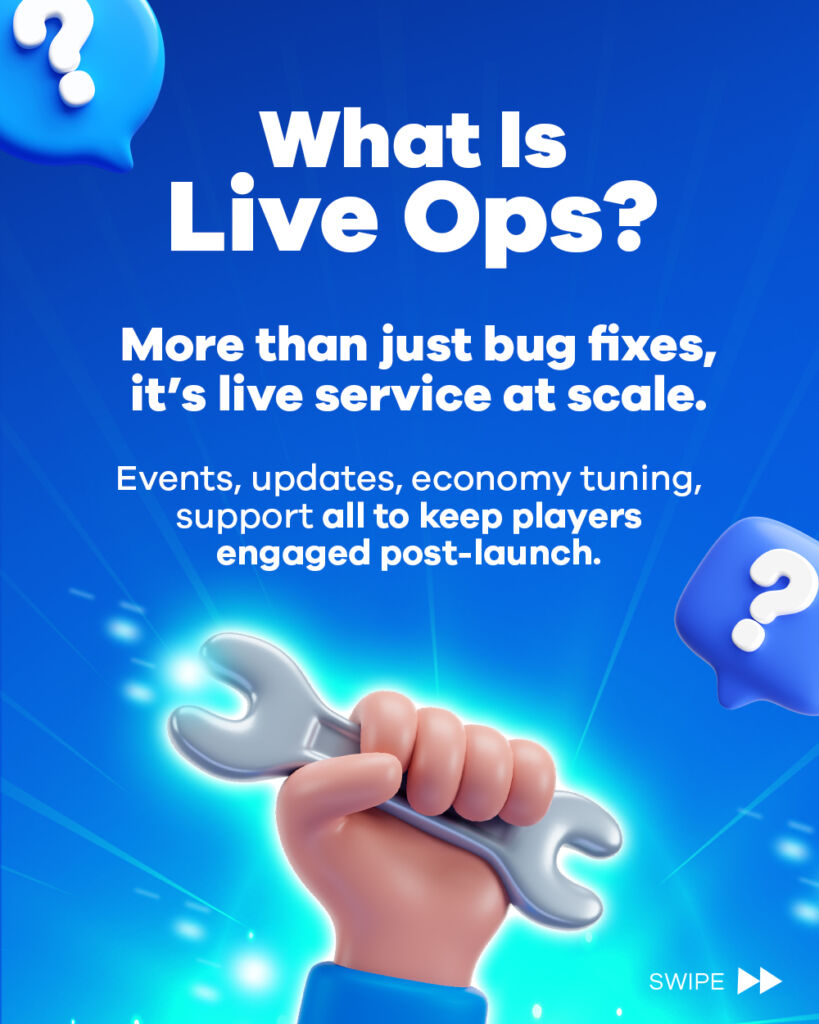
What Is Live Ops?
Live Ops department (Live Operations) is what keeps a game alive after launch day. It’s not just about bug fixes — it’s about running your game like a service, with updates, events, and features that keep players coming back.
At TapNation, Live Ops kicks in once a game scales profitably. When a title shows strong performance and long-term potential, it’s handed off from publishing managers — who focus on signing new developers and launching hits — to Live Ops producers.
That’s when their work begins: continuous content updates, in-game events, feature testing, economy tuning, player support, and promotional campaigns. The goal? Keep engagement high, retention strong, and revenue steady — week after week.
Live Ops is where great games keep winning after the launch hype fades.
Now let’s dive into the topic!
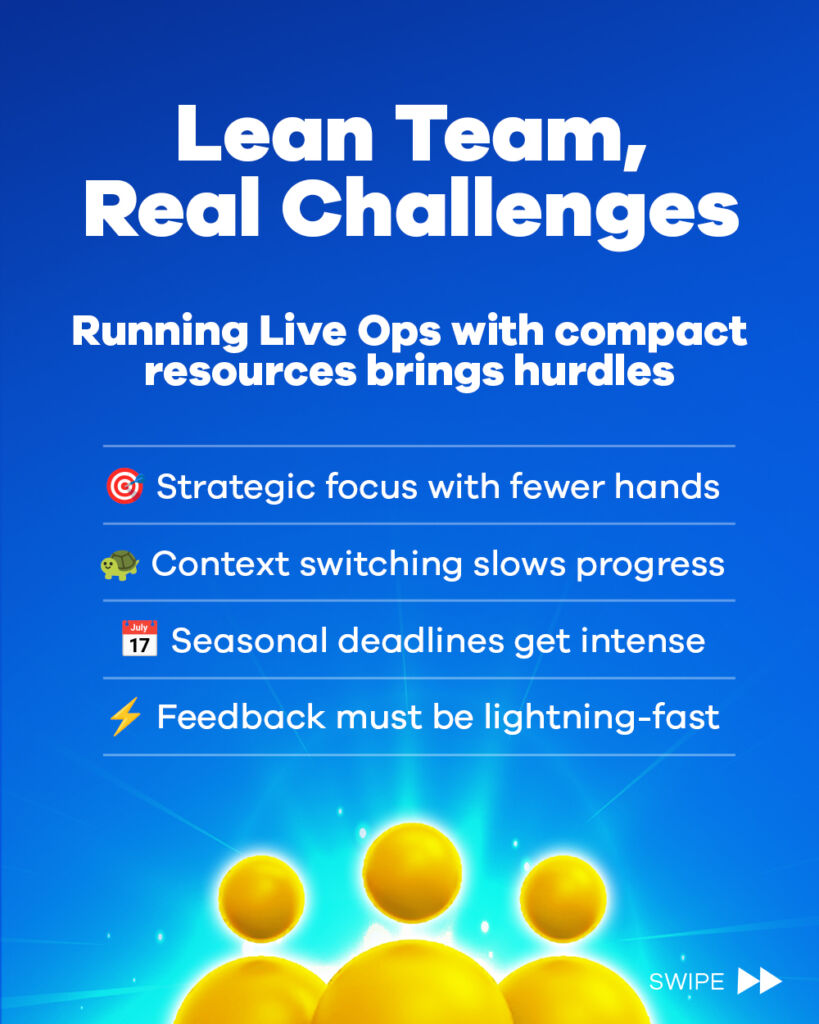
The Challenges of Live Ops with Optimized Resources
Running lean means making smart trade-offs — and that brings its own set of challenges. Here’s what that looks like on the ground:
1. Limited Hands, Strategic Focus
One dev per project (sometimes covering multiple games), a couple of game designers for an entire division that leads to shared resources — so prioritization is everything.
2. Context Switching Slows Teams Down
Without dedicated ownership, knowledge gaps can build up — especially when teams juggle multiple games. That’s why clear processes are essential, so everyone is aligned from the start, not just when a release is around the corner.
3. Tight deadlines Are Real — Especially During seasonal events
Big calendar moments (like Christmas) hit hard. QA gets swamped. Releases can get delayed. That’s why running weekly release planning meetings between QA and Live Ops is beneficial — to anticipate, not react.
4. Feedback Loops Can’t Be Slow
Teams can’t afford days of back-and-forth. That’s why reviews are streamlined — like using screen recordings for visual feedback instead of full builds. We’ll break down more of these practical tools and time-saving hacks later in the article.

TapNation’s lean Live Ops strategy has delivered impressive results. In 2022, with just 50 people in the company — and only 15 in Live Ops — we hit €45 million in revenue, marking our third consecutive year of profitability. Our games have surpassed 1 billion downloads globally, with 30 titles reaching top global rankings. This success earned us the #1 spot in France’s “Champions de la Croissance 2024” and the #14 position in the Financial Times FT1000 list of Europe’s fastest-growing companies.

How We Manage Live Ops at TapNation?
You don’t need a huge team to make Live Ops work — you need tight processes, the right tools, and strong communication. At TapNation, Live Ops isn’t just about optimizing games to increase revenue — it’s also about optimizing how we work to reduce costs.
“Our job as Live Ops managers is to absorb the noise — so everyone else can focus on their craft. As Head of Live Ops, I manage, delegate, and optimize workflows so the team can focus on what they do best — devs code, designers fine-tune gameplay, QA keeps the experience smooth.” — Philippe Naffah, Head of Live Ops at TapNation
Here’s our approach:
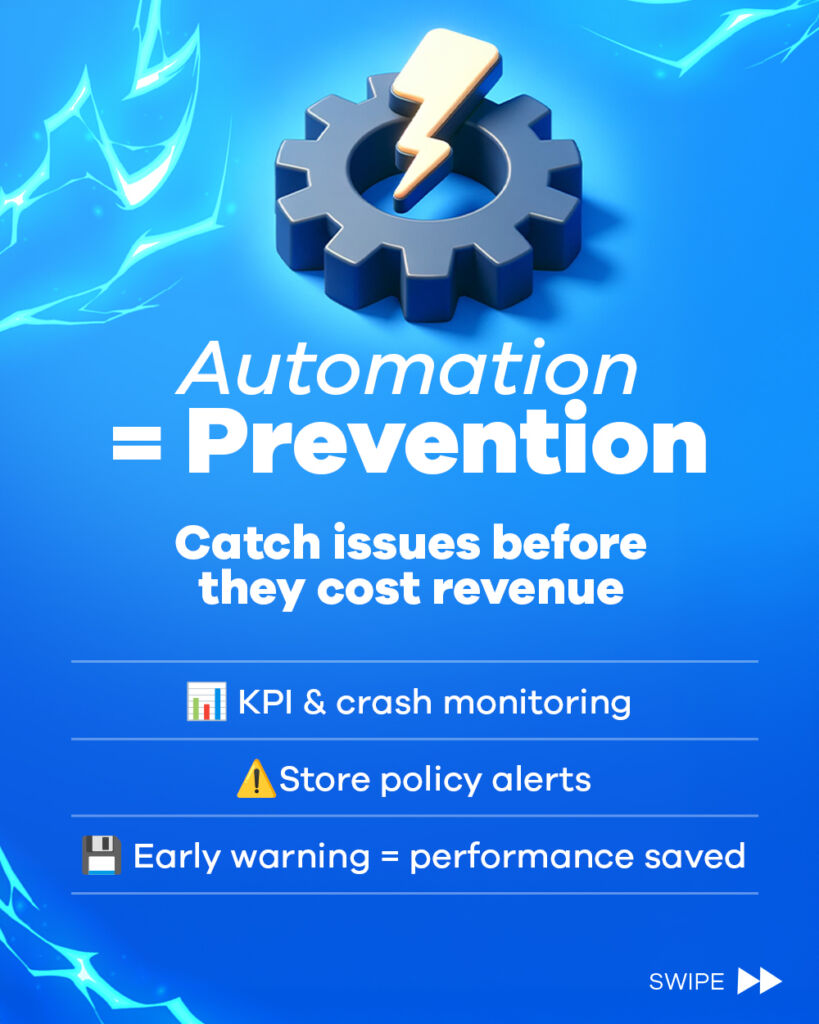
Repeatable Rituals over Reinventing the Wheel
Consistency and structure save time. We standardize our workflows across all games, including:
- Weekly syncs and planning calls
- Pre-built templates for releases, event packs, and promotions
- Task sprints with concrete goals — a playable feature, a new mechanic, a UI update, etc.
- Constant usage of AGILE and Scrum methodology for quick feedback and improvements
- Checklists that ensure QA, builds, and assets stay aligned
Automate to Catch Problems Before They Hit
Automation isn’t just about saving time — it’s about saving revenue.
TapNation Live Ops teams set up custom alarms on:
- KPIs like playtime, retention, crashes, and ANRs (App Not Responding)
- Store alerts (policy changes or update deadlines)
Miss one? The cost isn’t just downtime. It can be tens of thousands in lost UA momentum. These systems now catch issues early — before they tank performance.
Everyone Plays Their Position
Live Ops isn’t about micromanaging. It’s about enabling specialists to do their job better:
- Producers own the coordination: planning, feedback loops, and release alignment
- Artists, developers, and QA stay focused on execution
- Feedback is structured, fast, and tracked
One Stack to Rule Them All
Too many tools? Chaos? Keep things tight.
That’s our core:
- Slack for daily communication and quick feedback
- Jira for task and release management
- Notion for documentation and team knowledge
- Gather for quick conversations that replace days of Slack delays
- Trello for external collaborators
- Game Analytics + internal dashboards for tracking game performance live
One stack. One rhythm. Fewer blockers.
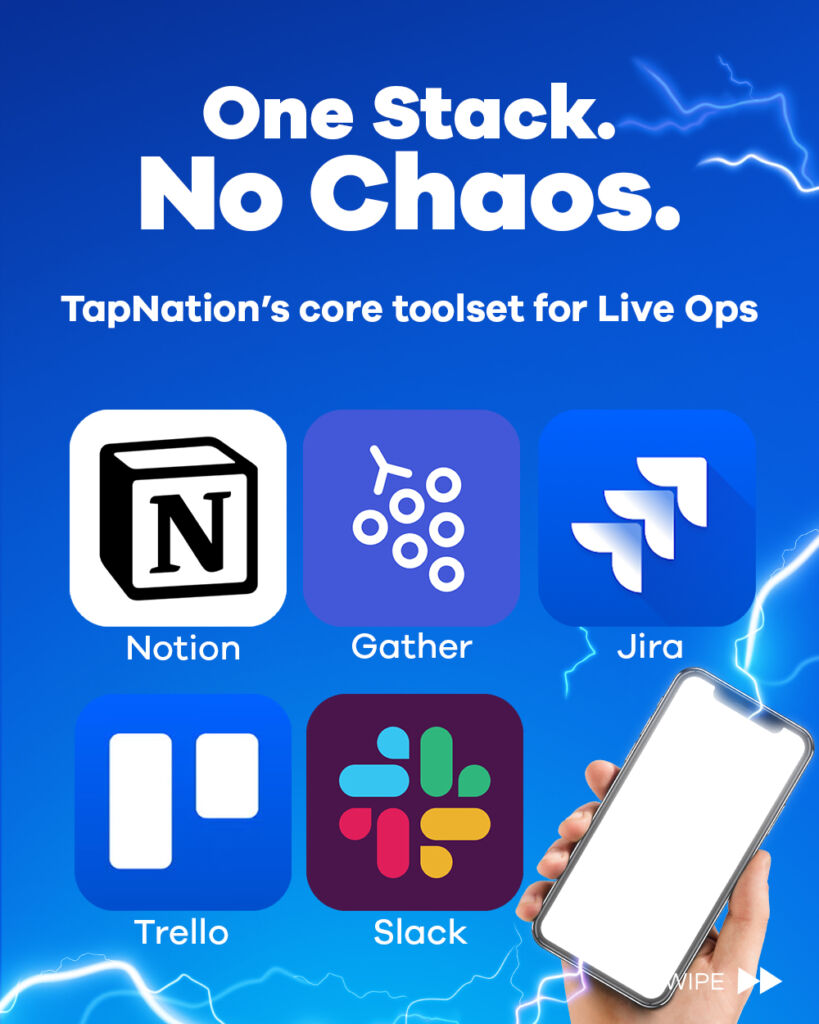
How to Manage Cross-Team Work Without Slowing Down?
Live Ops touches every part of the organization — UA, QA, product, support. To move fast without breaking things here’s what we always check off:
✅ Dedicated channel per game to avoid scattered info
✅ Weekly alignment calls with QA and UA to plan smooth rollouts
✅ Transparent Jira timelines so tasks don’t collide or bottleneck
✅ Flexible task handoffs when shared resources (like artists) need to be reallocated
It’s not about being reactive — it’s about being ready. The right system turns limited bandwidth into high output.
Final Thought
Live Ops isn’t just for massive studios. With smart planning and lean systems, small teams can deliver world-class service and scale efficiently.
At TapNation, we’ve built a model where Live Ops isn’t just support — it’s a growth engine with strategy.

🎯 Want to publish your hybrid casual game with us?
Submit your game and partner with us.
Resources
[1] – https://tech.eu/2023/11/06/paris-based-tapnation-raises-eur15m-to-boost-mobile-game-publishing
[2] – https://www.pocketgamer.biz/tapnation-on-the-journey-beyond-one-billion-downloads/
[3] – https://www.lesechos.fr/weekend/business-story/champions-de-la-croissance-2024-une-formidable-diversite-2075172
[4] – https://europeangaming.eu/portal/latest-news/2024/03/01/153982/french-publisher-tapnation-tops-financial-times-ft1000-list-of-europes-leaders-in-tech-media/


